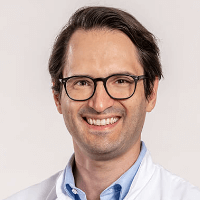Lung Cancer — Embolization or Chemoembolization: treatment in the Best Hospitals of Germany
Treatment prices are regulated by national law of the corresponding countries, but can also include additional hospital coefficients. In order to receive the individual cost calculation, please send us the request and medical records.

Department of Interventional Radiology
The Department of Interventional Radiology offers the full range of imaging examinations, as well as innovative image-guided minimally invasive techniques for the treatment of tumors, vascular diseases and internal pathologies (for example, CT, MRI, PET-CT, SPECT). The department's doctors have deep knowledge and colossal experience in the field of interventional radiological methods of treatment, which represent an excellent alternative to open surgical interventions. Despite the high level of technical equipment and the presence of advanced computerized systems, the focus is always on the person with his individual needs. Compliance with current clinical protocols and high professionalism of the department's specialists contribute to the successful clinical practice, as well as the reputability of the department among the best medical facilities of this kind in Germany.




Department of Interventional Radiology and Neuroradiology
The Department of Interventional Radiology and Neuroradiology offers a full range of advanced imaging diagnostics and minimally invasive treatments on both an inpatient and outpatient basis. The department has state-of-the-art medical equipment for imaging tests such as X-ray, computed tomography, magnetic resonance imaging, digital subtraction angiography, and mammography. The medical facility also performs many highly effective interventional therapeutic procedures under image guidance, which in many cases allow patients to avoid traumatic open surgery. For example, the department successfully performs local fibrinolysis, thrombectomy, percutaneous transluminal angioplasty, hemostasis, transarterial chemoembolization, uterine artery embolization, and other procedures. The department's neuroradiologists specialize in brain and spinal cord imaging and the treatment of central nervous system disorders. Interventional neuroradiology focuses on the treatment of carotid artery stenosis, brain aneurysms, arteriovenous malformations, dural fistulas, subdural hematomas, brain tumors, skull base and spinal tumors, and chronic back pain. The department's medical team has extensive clinical experience in their areas of expertise. The specialists are guided by the recommendations of the German Society for Interventional Radiology and Minimally Invasive Therapy (DeGIR) and the German Society for Neuroradiology (DGNR), which helps to achieve the best results.






Department of Adult and Pediatric Diagnostic, Interventional Radiology, Neuroradiology
The Department of Adult and Pediatric Diagnostic, Interventional Radiology, Neuroradiology is one of the best institutions of its kind in Germany and offers patients the full range of radiological studies and imaging-guided minimally invasive therapy. The department’s scope of tasks also includes imaging diagnostics in children of all age groups, detection and invasive treatment of cerebral vascular pathology (neuroradiology). Patient care is provided both on an inpatient and outpatient basis.






Lung cancer is the most common malignant tumor worldwide, with 2.1 million new cases being recorded annually. It is also the world's leading cause of death from cancer. Men over the age of 65 who smoke are most affected. The preferred treatment options for the disease are surgery and radiation therapy, but if these are contraindicated or the tumor has recurred, chemoembolization is used in developed countries. This is a safe, minimally invasive procedure that is well tolerated, rarely causes complications, and does not require any rehabilitation.
Content
- How is lung cancer treated?
- What are embolization and chemoembolization?
- Who may be a candidate for chemoembolization?
- How is chemoembolization performed?
- How effective is chemoembolization?
- Where can I undergo treatment?
How is lung cancer treated?
Surgery is considered to be the best treatment with the highest survival rate for patients. This may be a segmental resection or an extended pneumonectomy. In developed countries, doctors also perform minimally invasive operations, such as video-assisted thoracoscopic lobectomy (VATS) and robot-assisted Da Vinci lobectomy.
Unfortunately, symptoms of lung cancer appear late, and screening for this disease is not done. Therefore, the main treatment methods for most patients are chemotherapy and radiation therapy. Doctors abroad also use proton therapy, which is an even safer method. In recent years, immunotherapy and targeted therapy have become widespread, and these are more effective than systemic chemotherapy.
Chemoembolization for lung cancer is used as an additional method of local tumor control. It causes tissue necrosis due to a lack of blood supply, damages cancer cells with chemotherapy, and at the same time prevents or stops pulmonary hemorrhages, which are a common complication in the advanced stages of cancer.
What are embolization and chemoembolization?
Doctors use both embolization and chemoembolization to treat lung cancer.
Embolization for lung cancer in Germany in its pure form is mainly carried out as a palliative procedure. It stops pulmonary hemorrhage and relieves hemoptysis. Embolization of the bleeding vessels can be performed as an emergency procedure whenever required. The essence of the method is that particles or liquid materials are administered into the arteries of the lungs through the blood vessels in the groin area, which clog their lumen. These can be microspheres, spirals, polyvinyl alcohol particles, adhesive compositions, or other materials.
The procedure is very effective. Studies show that after its performance, the risk of recurrent bleeding within 6 months of medical observation is only 8%. Should a relapse occur, the procedure can be repeated.
Chemoembolization is usually performed with drug-saturated microspheres. They contain cytostatics, such as adriamycin or gemcitabine. The technique is used not only to stop and prevent pulmonary hemorrhages but also to shrink the tumor, improve its long-term control, create conditions for subsequent systemic therapy, and increase the life expectancy of patients.
Chemoembolization works through the following two mechanisms:
- Vascular tumor necrosis due to a lack of blood supply
- Damage to cancer cells by cytostatics released from drug-saturated microspheres
Thus, this procedure is a type of regional chemotherapy. It is more effective than systemic chemotherapy by creating a greater concentration of the drug at the site of the lesion. At the same time, regional chemotherapy is less toxic because the concentration of drugs in the systemic circulation is minimal.
It is also assumed that chemoembolization enhances the antitumor immune response due to the massive destruction of cancer cells and the release of their antigens into the blood. This effect may be beneficial for patients with metastatic cancer.
Who may be a candidate for chemoembolization?
Surgery is considered the main method of local treatment for lung cancer. If it is not possible due to an advanced stage or is contraindicated for health reasons, radiation therapy will be performed. Chemoembolization is therefore usually used for stage II-IV lung cancer if surgery and radiation therapy are impossible or contraindicated. In addition, the procedure can be performed in cases where the disease recurs or continues to progress after chemoradiotherapy.
The main advantage of chemoembolization is that the treatment is well tolerated, has minimal contraindications, and is suitable even for debilitated and elderly patients. The condition for its successful performance is an established path of blood supply to the tumor. Angiography (contrast-enhanced X-ray scanning of the lung blood vessels) is required to determine whether a patient can be a candidate for chemoembolization.
How is chemoembolization performed?
This is a minimally invasive endovascular procedure that is performed under local anesthesia combined with intravenous sedation. It is done through a small incision in the groin area. The doctor performs all actions from inside the blood vessels under X-ray guidance.
The doctor reaches the blood vessels of the lungs through a network of arteries. A contrast agent is then injected to evaluate the blood supply. Microspheres containing chemotherapy drugs are injected into the blood vessels supplying the tumor, usually the bronchial arteries. In this case, other blood vessels can be temporarily closed with coils to avoid emboli getting into them.
Less commonly, the blood vessels feeding the tumor are the branches of the subclavian artery and the inferior phrenic arteries.
Microspheres with a diameter of 100-300 microns are mainly used for chemoembolization. If the contrast agent continues to enter the tumor, additional microspheres of 300-500 microns are used.
The tumor can sometimes be supplied with blood from several arteries at once. In this case, each of them is sequentially closed with emboli.
How effective is chemoembolization?
Research shows the procedure shrinks tumors in most patients and improves survival rates.
In one of the studies, the authors compared the effectiveness of chemoembolization and regional chemotherapy, which involves injecting a solution of chemotherapy drugs into a bronchial artery. It turned out that chemoembolization works better. The procedure achieved an objective response (tumor shrinkage) in 86.7% of patients, compared to 60% in the regional chemotherapy group. The six-month survival rate was also higher: 87.5% versus 52.7%.
Another study showed that chemoembolization achieved one-year survival in 67% of patients. This is a good result, considering that the procedure is performed at an advanced stage of cancer, when surgery is impossible and radiation therapy is contraindicated or has already been used previously.
Where can I undergo treatment?
Embolization and chemoembolization are technically complex procedures. It is better to undergo these procedures in advanced hospitals with extensive experience in endovascular treatment. Failures are possible at various stages. This is due to the fact that first it is necessary to determine the characteristics of the blood supply to the tumor and then to clog the arteries with emboli while avoiding embolization of non-target blood vessels. In the best hospitals for lung cancer, the procedure has a technical success rate of more than 90%, even if the tumor has a blood supply from multiple sources.
You are welcome to use the Booking Health service to find out prices for individual procedures and the total cost of treatment and make an appointment for your lung cancer diagnostics and lung cancer treatment in Germany. Clinics in Germany use advanced techniques that allow them to successfully cope with aggressive types of cancer. When you opt to undergo your treatment in Germany, chemoembolization can be successfully combined with systemic methods of therapy and palliative procedures. Although it cannot cure advanced cancer, this treatment significantly increases the life expectancy of patients and eliminates hemoptysis.
Authors:
The article was edited by medical experts, board-certified doctors Dr. Nadezhda Ivanisova and Dr. Vadim Zhiliuk. For the treatment of the conditions referred to in the article, you must consult a doctor; the information in the article is not intended for self-medication!
Sources:

